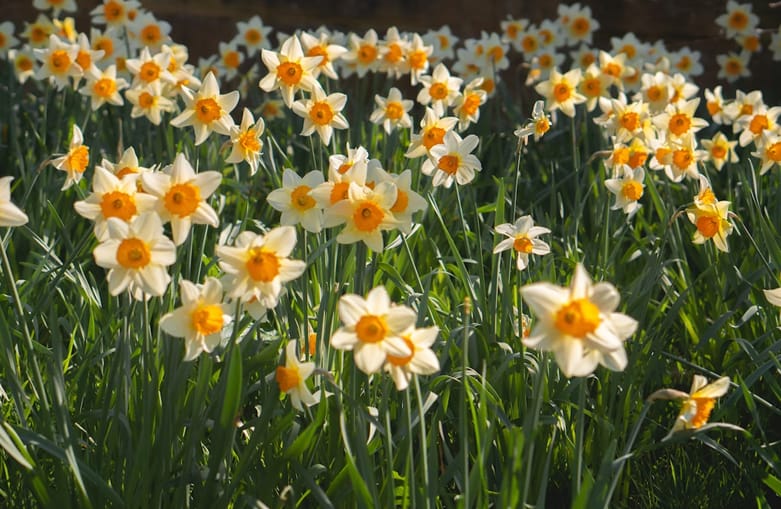When you think of planting bulbs in a landscape, you likely envision low-lying and wide open spaces. However, that’s not always the case.
Sometimes your yard is more like a hillside than a flat field, but that doesn’t mean you can’t plant bulbs there! Fortunately, you have plenty of options for how to plant flower bulbs on a hill using less bulbs.
Plan your bulb placement in advance
You can’t just plop a bulb wherever you think it looks nice. Your flower bulbs need to be placed in spots that will get the right amount of sunlight, have the right type of soil, and be in a place where they’re unlikely to be trampled.
Placing your bulbs before you plant will help you plan out your design and ensure you have the right bulbs in the right places.
If you’re working with a gentle slope, you can plant your bulbs side-by-side, which will allow them to keep each other upright and create a nice planted pathway. However, if you’re dealing with a steeper hillside, you’ll want to stagger your bulbs so that they aren’t sliding down the hill as they grow.
And regardless of the slope, if your bulbs will be growing in an area with lots of foot traffic, you’ll want to stagger them so that people can walk between them easily.

Choose flower bulbs that are suitable for planting on a hillside
Not all bulbs are created equal, and not all bulbs will thrive in sloping or steep areas — especially when you’re planting them on a hill.
When planting bulbs on a hill, you want to make sure you select bulbs that can handle the added stress of being planted in a less-than-ideal environment.
- Some bulbs, like tulips and daffodils, want to be planted in well-drained soil. Filling your planting area with sand could help you achieve this.
- For bulbs that need to be planted in soil with a higher pH level, like hyacinths and other spring-blooming bulbs, you can add some materials to the soil that will help bring it down to the right level.
Create a “ledge” with rocks and soil to hold your bulbs in place
If you’re planting on a hillside, there’s a good chance your soil isn’t very dense. That means your bulbs may be more likely to sink into the soil and be hidden from view.
So how can you prevent this from happening when you think about how to plant flowers on a hill? By creating a “ledge” with rocks and soil.
For this technique, you’ll want to start at the top of the hill and work your way down. Create a shallow planting hole for your bulbs, and then add a couple of rocks to the hole and a thin layer of soil.
The rocks will help to hold the bulbs in place, and the soil will help to anchor them as they grow. This can be especially helpful if you’re planting bulbs on the smaller side or that are particularly top-heavy.
Place rocks between the bulbs as you work your way down the hill, using the rocks as a barrier to keep the soil from falling in between the bulbs. This is a great way to help your bulbs thrive in tough growing conditions while also creating a beautiful display.
Use stakes to help secure your bulbs and keep them from tumbling downhill
This technique is especially helpful if you have a very steep hillside. It’s also a good idea if you’re planting bulbs in the sand, as they tend to sink into it more easily.
Using stakes to hold your bulbs in place is like planting a bulb in a pot and then putting the pot on the ground.
What’s nice is that you can place the bulbs at an angle so they’re growing down the hill instead of across it. To help secure your bulbs to the stakes, you can use garden twine or even old pantyhose.
Use plants with rosettes or dense leaves to anchor your bulbs on the slope
There are also plenty of flowers to plant on a hill that you can use to help anchor your bulbs on the slope. Great options include plants with large or dense leaves, like:
- hostas,
- ferns,
- and native grasses.
You can also use plants with rosette-shaped leaves, like columbine, epimedium, or hellebores, to help keep your bulbs in place.
Rosette-shaped plants are often very good at naturally creating a barrier between your bulbs and the rest of your garden or landscaping. They also tend to be on the lower side, which is helpful if you’re working with a steep hillside.
Conclusion
Bulbs are a great way to add color and interest to your garden, especially in the spring, when many plants are just starting to come out of dormancy. If you have a hillside in your yard, you can still plant bulbs in it — you just have to be a bit more strategic about it.
To plant flower bulbs on a hill, you can either stagger them so that they’re not all in a line or create a sort of “ledge” with soil and rocks to keep them in place. You can also use plants with dense leaves or rosettes to help keep your bulbs in place.
